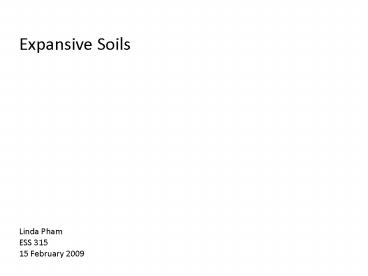Expansive Soils PowerPoint PPT Presentation
1 / 14
Title: Expansive Soils
1
Expansive Soils
Linda Pham ESS 315 15 February 2009
2
expansive soils are types of soil that shrink or
swell as the moisture content decreases or
increases. These soils typically contain clay
minerals that attract and absorb water. clay
particles have the smallest granular size and
become tightly packed together in sheet layers
and are nearly impervious holes and voids are
small. Nagel, David. "Soil Science for
Vegetable Producers." MSU Coordinated Access to
the Research and Extension System. 2001.
Mississippi State U. 6 July 2008
lthttp//msucares.com/pubs/publications/p1977.htmgt.
Definition Expansive Soils
3
- 1. Smectites, or montmorillinitic clays, are more
complex, flat crystals that form in younger
soils. - 2. Illitic clays are found only in young soils.
- 3. Kaolinitic clays are six-sided flat crystals
formed in highly weathered soils. - Smectite clays are made of two layers or sheets
of crystal units loosely held together. When
these clays get wet, the sheets get farther
apart. When these clays dry, the sheets get
closer together. - Illitic clays also are made of two sheets, but
potassium ions between the sheets do not allow
the clay to swell. - Kaolinite has only one layer and is not subject
to the shrink-swell phenomenon.
Clay Groups Properties Expansive Soils
4
The bond between the tetrahedral layers are weak,
allowing water and other molecules to penetrate
in between the voids which causes
expansion. http//pubs.usgs.gov/of/2001/of01-041/h
tmldocs/clay.htm
Smectite clay, large surface area, absorbs water.
http//www.uwsp.edu/geo/faculty/lemke/geog101/lect
ure_outlines/13_global_soil_patterns.html
http//soils.landcareresearch.co.nz/
Smectite Clays Expansive Soils
5
Non-expanding clay. Two tetrahedral layers with
a central octahedral sheet. Used to make
ceramics also used in health products to improve
digestive system.
Mojave County, Arizona. A kaolinite mining site
where the clay is extracted from the land to use
as cement and high strength concrete
mixes. http//www.nzlegacy.com/NZ20Minerals2
0LLC.htm
http//pubs.usgs.gov/of/2001/of01-041/htmldocs/cla
y.htm Photo http//www.dkimages.com/discover/DKIM
AGES/Discover/Home/Science/Earth-Sciences/Geology/
Rocks/Sedimentary/Clay/Clay-7.html
Illite Clays Expansive Soils
6
Over 50, high swelling
Under 50, high swelling
Over 50, slight to moderate swelling
Under 50, slight to moderate swelling
Little or no clays with swelling potential
Insufficient data
Map Expansive Soil Profiles Expansive Soils
7
Distribution of expansive soils, shown in brown,
in the United States.
From Geology and the Environment
Expansive Soil Map Expansive Soils
8
Water from rainfall and other sources is stored
in expansive soils, causing swelling. It
increases pore pressure and can uplift sidewalks,
foundations, and more.
When droughts and intense warming occurs, the
clays lose their moisture content and shrinks.
Foundations can crumble from the loss of the
support.
Activity Expansive Soils
9
http//1510365blog.wordpress.com/2008/03/17/077-re
-hydrating-soil/
Expansive soils dry out and cracks.
Dry conditions Expansive Soils
10
- Swelling of soil causeslarge uplift pressureon
structures, such as foundations and slabs. - About 6 billion in damages in U.S. each year
Photo http//1510365blog.wordpress.com/2008/03/15
/075-photograph-cracks/
Wet conditions Expansive Soils
11
Photo http//www.bgs.ac.uk/products/geosure/shrin
k_swell.html
Damages Expansive Soils
12
http//web.mst.edu/rogersda/expansive_soils/
Damages Expansive Soils
13
http//web.mst.edu/rogersda/expansive_soils/
Damages Expansive Soils
14
- Remove the expansive soil.
- Mix the soil with nonexpansive material.
- Mix in chemicals to change the way the clay
reacts with water. - Keep the soil moisture constant.
- Use reinforced foundations that are designed to
withstand soil volume changes. - Ensure proper drainage away from the foundation.
- From Geology and the Environment,
http//www.paccrestinspections.com/expansive.htm
Treatment Expansive Soils

